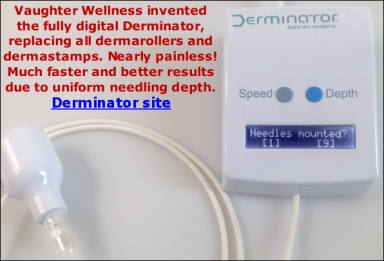I re-post the essence here after erroneously having deleted the entire thread:
We have received the copper peptide facial masks. They are non-comedogenic.
We sell the GHK-Cu facial masks for just 3 dollars, and they are excellent after dermarolling the face with needles of any length. The facial mask is applied after dermarolling. When your face has dried, you can apply Infadolan ointment to selected spots. Our masks contain
2000 ppm GHK-Cu/a>. [url=http://www.owndoc.com/dermarolling/copper-peptides-for-dermarolling/]GHK-Cu is the best copper peptide for skin rejuvenation and collagen regeneration.
Buy our copper peptide facial mask<strong>Ingredient list:</strong>
Carbomer (Carboxypolymethylene) 10 %
TEA (Triethanol amine) 0.1 %
Hyaluronic Acid 0.3 %
GHK-Cu 0.1 % (1000 ppm)
Nano Platinum 0.1 %
Centella Extract 2 %
Yam Extract 2 %
Syn-Coll (PALMITOYL TRIPEPTIDE-3) 2 %
Vitamin B3 0.2 %
Vitamin B5 0.3 %
1,3 Butylene Glycol 5 %
Propylene Glycol 3 %
Propyl paraben 0.1 %
Tween 20 0.1 %
Fragrance 0.01 %
The rest is deionized water.
It is found that in poor connective tissue conditions, the triterpenes in<strong> Centella asiatica</strong> are able to renew the collagen, in quantity and quality, and restore tissue firmness and skin elasticity, improving skin appearance and comfort. Apart from this it also has anti-psoriatic properties.
(Reference Aesthetic Plastic Surgery, May-June 2000, pages 227-234;
Phytomedicine, May 2001, pages 230-235; and Contact Dermatitis, October 1993, pages 175-179)
<strong>Pantothenic acid, also called vitamin B5</strong>
Wound Healing
A study in 1999 showed that pantothenic acid has an effect on wound healing
in vitro[51]. Wiemann and Hermann found that cell cultures with a
concentration of 100μg/mL calcium D-pantothenate increased migration, and
the fibres ran directionally with several layers, whereas the cell cultures
without pantothenic acid healed in no orderly motion, and with fewer
layers[52]. Cell proliferation, or cell multiplication was found to increase
with pantothenic acid supplementation[53]. Finally, there were increased
concentrations of two proteins, both of which have still to be been
identified, that was found in the supplemented culture, but not on the
control[54]. Further studies are needed to determine whether these effects
will stand in vivo.
<strong>Acne</strong>
Following from discoveries in mouse trials, in the late 1990s a small study
was published promoting the use of pantothenic acid to treat acne vulgaris.
According to a study published in 1995 by Dr. Lit-Hung Leung,[62] high doses
of Vitamin B5 resolved acne and decreased pore size. Dr. Leung also proposes
a mechanism, stating that CoA regulates both hormones and fatty-acids, and
without sufficient quantities of pantothenic acid, CoA will preferentially
produce androgens. This causes fatty acids to build up and be excreted
through sebaceous glands, causing acne. Leung's study gave 45 Asian males
and 55 Asian females varying doses of 10-20g of pantothenic acid (100000% of
the US Daily Value), 80% orally and 20% through topical cream. Leung noted
improvement of acne within one week to one month of the start of the
treatment.
http://en.wikipedia.org/wiki/Pantothenic_acid <strong>Topical Use of Dexpanthenol in Skin Disorders</strong>
Authors: Ebner F.1; Heller A.2; Rippke F.2; Tausch I.3
Source: American Journal of Clinical Dermatology, Volume 3, Number 6, 1 June
2002 , pp. 427-433(7)
Publisher: Adis International
Abstract:
Pantothenic acid is essential to normal epithelial function. It is a
component of coenzyme A, which serves as a cofactor for a variety of
enzyme-catalyzed reactions that are important in the metabolism of
carbohydrates, fatty acids, proteins, gluconeogenesis, sterols, steroid
hormones, and porphyrins. The topical use of dexpanthenol, the stable
alcoholic analog of pantothenic acid, is based on good skin penetration and
high local concentrations of dexpanthenol when administered in an adequate
vehicle, such as water-in-oil emulsions. Topical dexpanthenol acts like a
moisturizer, improving stratum corneum hydration, reducing
transepidermal water loss and maintaining skin softness and elasticity.
Activation of fibroblast proliferation, which is of relevance in wound healing, has been
observed both in vitro and in vivo with dexpanthenol. Accelerated
re-epithelization in wound healing, monitored by means of the transepidermal
water loss as an indicator of the intact epidermal barrier function, has
also been seen. Dexpanthenol has been shown to have an anti-inflammatory
effect on experimental ultraviolet-induced erythema.
Beneficial effects of dexpanthenol have been observed in patients who have
undergone skin transplantation or scar treatment, or therapy for burn
injuries and different dermatoses. The stimulation of epithelization,
granulation and mitigation of itching were the most prominent effects of
formulations containing dexpanthenol. In double-blind placebo-controlled
clinical trials, dexpanthenol was evaluated for its efficacy in improving
wound healing. Epidermal wounds treated with dexpanthenol emulsion showed a
reduction in erythema, and more elastic and solid tissue regeneration.
Monitoring of transepidermal water loss showed a significant acceleration of
epidermal regeneration as a result of dexpanthenol therapy, as compared with
the vehicle. In an irritation model, pretreatment with dexpanthenol cream
resulted in significantly less damage to the stratum corneum barrier,
compared with no pretreatment. Adjuvant skin care with dexpanthenol
considerably improved the symptoms of skin irritation, such as dryness of
the skin, roughness, scaling, pruritus, erythema, erosion/fissures, over 3
to 4 weeks. Usually, the topical administration of dexpanthenol preparations
is well tolerated, with minimal risk of skin irritancy or sensitization.





